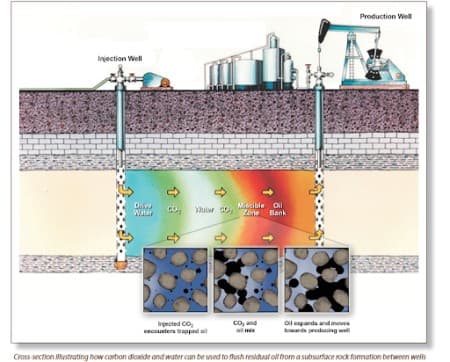Over the past few years, Big Oil has been heavily investing in carbon capture and storage (CCS) technology, ostensibly to offset CO2 emissions from the energy commodities they produce. Environmentalists have largely dismissed these efforts as mere greenwashing, with experts warning that CCS technology is so far unproven at the scale needed for meaningful decarbonization. Well, maybe environmentalists have been right all along, with new research revealing that carbon capture can extend the productivity of near-depleted oilfields for many decades. Calgary-based senior geological advisor Menhwei Zhao has conducted an AAPG Bulletin study regarding the use of CCS in Enhanced Oil Recovery (EOR). He analyzed more than 22 years of production data from the Weyburn Midale oil pool in Saskatchewan, which since 2000 has been receiving carbon dioxide injections thus making it the world’s longest-running EOR project. Zhao concluded that the pool would have stopped producing oil by 2016 without CO2 injection, but that “enhanced oil recovery could extend the pool’s lifespan to 39 or even 84 more years.” Although Zhao acknowledges that he focused on a specific project in Canada, he says he would expect to see “similar results” for large-scale CCS projects around the world.
Zhao’s claims might not be exaggerated: The Wasson Field’s Denver Unit CO2 EOR project resulted in a nearly seven-fold increase in crude production after injecting CO2.
These findings come at a time when Canadian and Alberta governments are lining up more than $15.3 billion in tax credits to the country’s largest oil sands producers for CCS projects. Canada is not alone. The U.K. government is promising £20 billion in CCS subsidies while U.S. oil and gas producers can obtain a tax credit of $85 for every tonne of carbon dioxide they bury in underground geological formations (the credit is lowered to $60 per tonne if the CO2 is used for EOR).
Related: Debate Rages Over Global Oil Demand
Last year, E&P giant Exxon Mobil (NYSE:XOM) acquired the developer of CCS solutions, Denbury Inc. (NYSE:DEN) in an all-stock transaction valued at $4.9B. Denbury recycles CO2 through its EOR operations, and uses it to produce environmentally-friendly, carbon-negative Blue Oil. Now one of Exxon’s subsidiaries, Denbury owns the largest CO2 pipeline network in the U.S. at 1,300 miles, including nearly 925 miles of CO2 pipelines in Louisiana, Texas and Mississippi, as well as 10 onshore sequestration sites. Last year, Exxon Mobil signed a long-term contract with industrial gas company Linde Plc. (NYSE:LIN) that involves offtake of carbon dioxide associated with Linde’s planned clean hydrogen project in Beaumont, Texas. Exxon will transport and permanently store as much as 2.2M metric tons/year of carbon dioxide each year from Linde’s plant.
Meanwhile, Exxon’s oil field services peer Schlumberger Ltd (NYSE:SLB) recently formed SLB New Energy unit that invests in five niche segments, including CCS. According to Gavin Rennick, president of SLB New Energy, each of these segments has a minimum addressable market of $10 billion per year.
CCS For EOR
Crude oil production in U.S. oil fields frequently encompasses three distinct phases: primary, secondary, and tertiary (or enhanced) recovery. During the primary recovery phase, gravity, the natural pressure of the reservoir and artificial lift techniques are used to drive oil into the wellbore. This initial phase typically recovers only about 10 percent of a reservoir's original oil in place (OOIP). Secondary recovery techniques are used to extend a field's productive life usually by injecting water or gas to displace oil and drive it to a production wellbore, typically resulting in the recovery of 20 to 40 percent of OOIP.
However, much of the easy-to-produce oil has already been recovered from U.S. oil fields, forcing producers to turn to several tertiary, or enhanced oil recovery (EOR), techniques. EOR technologies offer prospects for ultimately producing 30 to 60 percent, or more, of a reservoir's OOIP.
Three major categories of EOR have been found to be commercially successful: gas injection, chemical injection and thermal recovery. Gas injection is the most common EOR technology in the United States, accounting for nearly 60 percent of EOR production in the country. Gas injection uses gasses such as CO2, natural gas, or nitrogen that expand in a reservoir to push additional oil to a production wellbore while other gasses dissolve in the oil and help to lower its viscosity and improve its flow rate. CO2 injection has been used successfully throughout the Permian Basin of West Texas and eastern New Mexico, as well as in Kansas, Mississippi, Wyoming, Oklahoma, Colorado, Utah, Montana, Alaska, and Pennsylvania.

Source: DoE
ADVERTISEMENT
The U.S. DoE is currently researching novel techniques that could significantly improve the economic performance and expand the applicability of CO2 injection to a broader group of reservoirs. The DoE estimates that next-generation CO2-EOR has the potential to produce over 60 billion barrels of oil that would otherwise be left trapped in the rocks.
By Alex Kimani for Oilprice.com
More Top Reads From Oilprice.com:
- Matador Resources to Buy More Permian Assets in $1.9B Deal
- Oil Drops on Inventory Build
- Inflation in China is Finally Beginning to Stabilize



















However, the advantage of injecting CO2 from caught emissions serves another important goal of reducing the level of CO2 and storing it.
Still, under all scenarios, oil is here to stay and will continue to drive the global economy throughout the 21st century and far beyond.
Moreover, there are plenty of proven and newly discovered oil reserves with the last three barrels of oil produced coming from three regions of the world, the Gulf region, Venezuela's Orinoco Belt and the Russian Arctic.
So the environmental activists will have to live with oil production for at least the next 100 years whether they like it or not.
Dr Mamdouh G Salameh
International Oil Economist
Global Energy Expert.